|
|
|
|
 |
OTHER MAMMALS: Deer |
|
|

Fig. 1. White-tailed deer,
Odocoileus virginianus
 Introduction Introduction
Deer are probably the most
widely distributed and best-recognized large mammals in
North America. The white-tailed deer (Odocoileus
virginianus) (Fig. 1) is found throughout much of
North America. The mule deer (O. hemionus) is
primarily a western species restricted to buttes, draws,
and stream bottoms with sufficient forage. The
black-tailed deer (O.h. columbianus) is a
subspecies of the mule deer. Both white-tailed and mule
deer are very important game animals. In 1974 about 2
million white-tailed deer were harvested by over 8
million hunters. The trend in both harvest and hunter
numbers has been generally upward since then. The
positive economic value of deer through license fees,
meat, and hunter expenditures for equipment, food, and
transportation can be measured in hundreds of millions
of dollars. Hesselton and Hesselton (1982) estimated the
value of each deer harvested in the United States to be
$1,250. With the additional aesthetic value of deer to
landowners and vacationers, importance of deer as a
wildlife resource cannot be disputed.
Despite their economic and
aesthetic values, deer also have a variety of negative
economic impacts” they damage crops and personal
property, and harbor diseases common to humans and
livestock. Unlike moles, rats, and other species
implicated in damage, deer cannot be casually eliminated
when in conflict with humans. But neither can landowners
be expected to bear the entire burden of support for
this valuable public resource.
These factors often make
deer damage control a difficult social and political
problem as well as a biological and logistical one.
Control methods are built around effective deer herd
management. Thus the various state wildlife agencies are
often indirectly or directly involved through subsidy of
control techniques, direct damage compensation payments,
or technical advice.
Scare devices, repellents,
and shooting all have a place in deer damage control.
Effective control for fields, orchards, and other large
areas, however, usually depends on excluding the deer
with one of several types of fences, discussed later in
this chapter. Toxicants, fumigants, and in most cases,
trapping, are not used in deer control.
The volume of literature
on deer ecology and management exceeds that for any
other wildlife species. The best single reference is
Halls (1984). The following review is meant as a brief
summary using the white-tailed deer as an example. The
mule deer is very similar in all respects.
Identification
Deer are even-toed
ungulates of the family Cervidae. Adult animals may
weigh 50 to 400 pounds (23 to 180 kg) depending on
species and location. Their general form is well-known.
At birth, fawns are rust-colored with white spots. Their
spotted coats are shed in 3 to 4 months and are replaced
by a grayish-brown fall and winter coat. The summer coat
of adult animals is reddish-brown.
Underparts of the tail,
belly, chin, and throat are white during all seasons.
Antlers grow on males (bucks)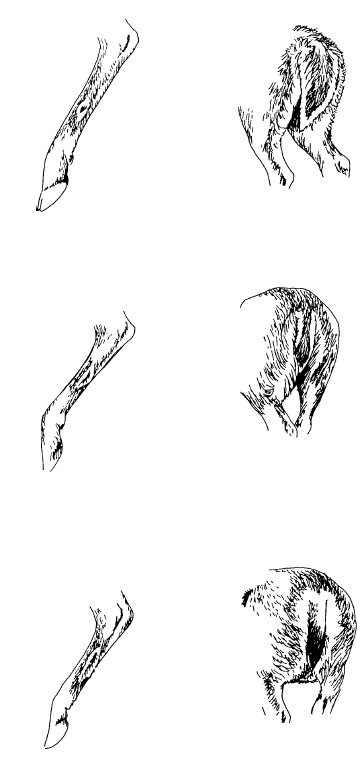 from April to August. Antler development is nourished by
a layer of soft, vascularized on the antlers. The dried
velvet layer is rubbed off and the antlers polished
during the fall rut (breeding season). Antler size
depends on nutrition, age, and genetics.
from April to August. Antler development is nourished by
a layer of soft, vascularized on the antlers. The dried
velvet layer is rubbed off and the antlers polished
during the fall rut (breeding season). Antler size
depends on nutrition, age, and genetics.
Mule deer antlers are
forked while the tines of a white-tailed deer's antlers
arise from a central beam. Both mule deer and
white-tails have deciduous antlers that are shed in
mid-winter. The rump and tail area and facial features
also differ slightly between the species (Fig. 2). Both
mule and white-tailed deer lack upper incisors.
 Range Range
The white-tailed deer is
found in every state in the United States except perhaps
Alaska and Utah. It occurs throughout the southern
provinces of Canada, across the United States, and on
into Central and South America (Fig. 3). Mule deer are
common throughout western Canada, western United States,
and into Mexico (Fig. 4). There are several subspecies
of both deer.
Habitat
Deer are creatures of the
forest edge rather than the dense, old-growth forest.
They thrive in agricultural areas interspersed with
woodlots and riparian habitat. They favor early
successional stages which keep brush and sapling browse
within reach. Dense cover is used for winter shelter and
protection.
Food Habits
Browse (leaves, stems, and
buds of woody plants) is generally available all year
and is a staple food for deer. An extensive review of
food habits can be found in Hesselton and Hesselton
(1982) and in Mackie et al. (1982). Plant species vary
considerably in quality and regional availability, so a
list is not presented here. Forbs are eaten in spring
and summer when available. Fruits and nuts (especially
acorns) are seasonally very important. Grasses are
relatively unimportant. Agricultural crops--corn,
soybeans, small grains, alfalfa, vegetables, and fruit
trees--are readily eaten when available. Local food
habits studies are available in most states--consult
your local wildlife agency.
Nutrient requirements and
the amount of food consumed vary with age of the animal,
season, and the reproductive cycle. Daily dry matter
consumption averages 2% to 4% of live body weight. For
adult bucks, daily consumption is greatest in spring and
averages 4.4 to 6.4 pounds (2.0 to 2.9 kg) of air-dry
food per day. Consumption is about half that during
winter. For does, greatest daily food consumption occurs
in early fall, just prior to the breeding season.
General
Biology, Reproduction, and Behavior
Breeding occurs from
October to January depending on latitude. Peak activity
is in November. Does are in heat for 24 hours every 28
days for 2 to 3 consecutive cycles. One buck may
inseminate several does. No pairing takes place. Most
does breed during their second fall, although on good
range up to 30% of the doe fawns (6 months old) will be
bred. Gestation is about 202 days. The peak of fawn drop
is in May or June. Most reproducing fawns give birth to
a single fawn, but adult does typically bear twin fawns.
Reproductive potential is very sensitive to nutrition.
Fawns weigh 7 to 8 pounds (3.2 to 3.6 kg) at birth and
increase in weight for 5 1/2 to 6 1/2 years. Adult size
varies with latitude. In northern states, a mature buck
may weigh 200 to 300 pounds (90 to 135 kg). A key deer
buck (white-tailed deer subspecies) in Florida may weigh
only 50 pounds (22.5 kg). Does average 25% to 40% less
than bucks for all subspecies.
Deer are most active in
early morning and evening. They have a home range of
several hundred acres (ha), but this varies with season,
sex, and habitat quality. In northern areas, deer gather
in dense cover for the winter. They may move long
distances from summer range to a winter yard. Life
expectancy is dependent on hunting pressure and
regulations. Records show whitetails living 20 years,
although 10 to 12 years is noteworthy in the wild.
Damage
and Damage Identification
 Deer
damage a wide variety of row crops, forage crops,
vegetables, fruit trees, nursery stock, and ornamentals,
as well as stacked hay. In addition to the immediate
loss of the crop being damaged, there is often residual
damage in the form of future yield reduction of fruit
trees or forage crops such as alfalfa. Ornamental trees
or nursery stock may be permanently disfigured by deer
browsing. Under high densities deer may severely impact
native plant communities and impair regeneration of some
forest tree species. Besides vegetative damage, deer/
vehicle collisions pose a serious risk to motorists, and
deer have been implicated in the distribution and
transmission of Lyme disease. Deer
damage a wide variety of row crops, forage crops,
vegetables, fruit trees, nursery stock, and ornamentals,
as well as stacked hay. In addition to the immediate
loss of the crop being damaged, there is often residual
damage in the form of future yield reduction of fruit
trees or forage crops such as alfalfa. Ornamental trees
or nursery stock may be permanently disfigured by deer
browsing. Under high densities deer may severely impact
native plant communities and impair regeneration of some
forest tree species. Besides vegetative damage, deer/
vehicle collisions pose a serious risk to motorists, and
deer have been implicated in the distribution and
transmission of Lyme disease.
Damage identification is
not difficult. Because both mule deer and white-tailed
deer lack upper incisors, deer often leave a jagged or
torn surface on twigs or stems that they browse. Rabbits
and rodents, however, leave a clean-cut surface. In
addition, deer tracks are very distinctive (Fig. 5). The
height of damage from the ground (up to 6 feet [1.8 m])
often rules out any mammal other than deer. Deer often
are observed of causing damage.
 Legal
Status Legal
Status
Deer are protected
year-round in all states and provinces, with the
exception of legal harvest during appropriate big-game
hunting seasons. In cases of severe or persistent
damage, some states may issue farmers special permits to
shoot deer at times other than the legal hunting
seasons. Regulations vary on the necessary permits and
on disposal of dead animals. The popularity of deer as
game animals and then need to curb poaching have led to
the development of severe penalties for illegal
possession. No lethal deer control can be initiated
before consulting your local state wildlife agency. By
law, some states provide technical assistance or direct
compensation for deer damage. This is discussed under
the section on the economics of damage and control.
Damage
Prevention and Control Methods
Exclusion
Where deer are abundant or
crops are particularly valuable, fencing may be the only
way to effectively minimize deer damage. Several fencing
designs are available to meet specific needs. Temporary
electric fences are simple inexpensive fences useful in
protecting garden and field crops during snowfree
periods. Deer are attracted to these fences by their
appearance or smell, and are lured into contacting the
fence with their noses. The resulting shock is a very
strong stimulus and deer learn to avoid the fenced area.
Permanent high-tensile electric fences provide
year-round protection from deer and are best suited to
high-value specialty or orchard crops. The electric
shocking power and unique fence designs present both
psychological and physical barriers to deer. Permanent
woven-wire fences provide the ultimate deer barrier.
They require little maintenance but are very expensive
to build. Fencing in general is expensive. You should
consider several points before constructing a fence,
such as:
History of the area —
assemble information on past claims, field histories,
deer numbers, and movements to help you decide on an
abatement method.
Deer pressure — this
reflects both the number of deer and their level of
dependence on agricultural crops. If deer pressure in
your area is high, you probably need fences.
Crop value — crops with
high market values and perennial crops where damage
affects future yields and growth often need the
protection fencing can provide.
Field size — in general,
fencing is practical for areas of 40 acres (16 ha) or
less. The cost per acre (ha) for fencing usually
decreases, however, as the size of the area protected
increases.
Cost-benefit analysis —
to determine the cost effectiveness of fencing and the
type of fence to install, weigh the value of the crop to
be protected against the acreage involved, costs of
fence construction and maintenance, and the life
expectancy of the fence.
Rapidly changing fence
technology — if you intend to build a fence yourself,
supplement the following directions by consulting an
expert, such as a fencing contractor. Detailed fencing
manuals are also available from most fencing
manufacturers and sales representatives.
Temporary Electric Fencing
Temporary electric fences
provide inexpensive protection for many crops during
periods without snow. They are easy to construct, do not
require rigid corners, and materials are readily
available. Install fences at the first sign of damage to
prevent deer from establishing feeding patterns in your
crops. Weekly inspection and maintenance are required.
Different types of temporary electric fences are
described below.
Peanut Butter Fence.
The peanut butter fence is effective for small gardens,
nurseries, and orchards (up to 3 to 4 acres [1.2 to 1.6
ha]) subject to moderate deer pressure. Deer are
attracted by the peanut butter and encouraged to make
nose-to-fence contact. After being shocked, deer learn
to avoid fenced areas. Cost, excluding labor, is about
$0.11 per linear foot ($0.30/m). This fence is not
widely used.
To build a peanut butter
fence (Fig. 6), follow the steps below.
(1) Install wooden corner
posts.
(2) String one strand of
17-gauge (0.15-cm), smooth wire around the corners and
apply light tension.
(3) Set 4-foot (1.2-m)
3/8-inch (1-cm) round fiberglass rods along the wire at
45-foot (14-m) intervals.
(4) Attach the wire to
insulators on the rods 2 1/2 (0.75 m) feet above ground
level and apply 50 pounds (22.5 kg) of tension.
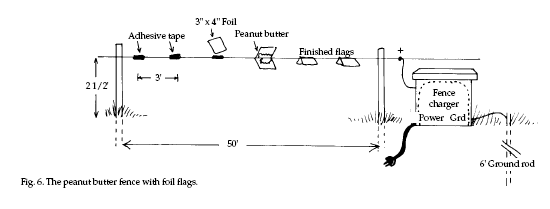
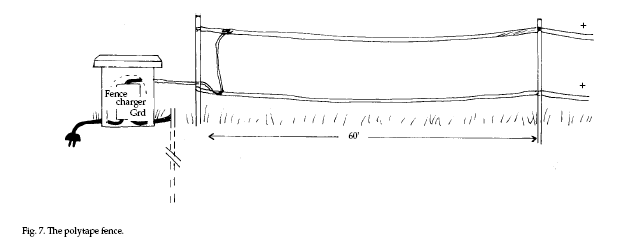
(5) Attach 3 x 4-inch (7 x
10-cm) foil strips to the wire at 3-foot (1-m)
intervals, using 1 x 2-inch (3 x 5-cm) strips of cloth
adhesive tape.
(6) Apply a 1:1 mixture of
peanut butter and vegetable oil to the adhesive tape
strips and fold the foil over the tape.
(7) Connect the wire to
the positive (+) post of a well-grounded fence charger.
(8) For fields larger than
1 acre (0.4 ha), it is more practical to apply the
peanut butter mixture directly to the wire. You can make
a simple applicator by mounting a free-spinning, 4-inch
(10-cm) pulley on a shaft inside a plastic ice cream
pail. Fill the pail with a peanut butter-vegetable oil
mixture that has the consistency of very thick paint.
Coat the entire wire with peanut butter by drawing the
pulley along the wire. Apply peanut butter once a month.
Attach foil flags to the fence near runways or areas of
high deer pressure to make the fence more attractive.
Check the fence weekly for damage by deer and grounding
by vegetation. Polytape Fence. Various forms of polytape
or polywire, such as Visible Grazing Systems® (VGS),
Baygard®, and Turbo-tape® are very strong and
portable. You can use these fences to protect up to 40
acres (16 ha) of vegetable and field crops under
moderate deer pressure. Deer receive shocks through
nose-to-fence contact and they learn to avoid fenced
areas. Cost, excluding labor, is about $.11 per linear
foot ($0.30/m).
To build a polytape fence
(Fig. 7), follow the steps below.
(1) Drive 5/8-inch
(1.6-cm) round fiberglass posts 2 feet (0.6 m) into the
ground at the corners.
(2) String two strands of
polytape (white or yellow are most visible) around the
corners and apply light tension (one strand 2 1/2 feet
(0.75 m) high can be used).
(3) Use square knots or
half-hitches to make splices or to secure the polytape
to corner posts.
(4) Set 4-foot (1.2-cm)
3/8-inch (1-cm) round fiberglass rods along the wires at
45-foot (14-m) intervals.
(5) Attach the two strands
of polytape to insulators on the rods at 1 and 3 feet
(0.3 and 0.9 m) above ground level and apply 50 pounds
(22.5 kg) of tension.
(6) Connect the polytape
to the positive (+) post of a well-grounded fence
charger.
(7) Use the applicator
described under Peanut Butter Fence
(8) to apply 2-foot
(0.6-m) swatches of peanut butter to the polytape every
6 feet (2 m) where deer presence is expected to be high.
To maintain the fence, check it weekly for damage by
deer and grounding by vegetation.
Permanent High-Tensile
Electric
Fencing High-tensile
fencing can provide year round protection from deer
damage. Many designs are available to meet specific
needs. All require strict adherence to construction
guidelines concerning rigid corner assemblies and fence
configurations. Frequent inspection and maintenance are
required. High-tensile fences are expected to last 20 to
30 years. Different types of high tensile electric
fences are described below.
Offset or Double Fence.
This fence is mostly for gardens, truck farms, or
nurseries up to about 40 acres (0.16 ha) that experience
moderate deer pressure. Deer are repelled by the shock
and the three-dimensional nature of the fence. You can
add wires if deer pressure increases. Cost, excluding
labor, is about $.35 per linear foot ($1/m).
To build an offset or
double fence (Fig. 8), follow the steps below.
For the outside fence: (1)
Install swing corner assemblies where necessary (see the
section on fence construction rigid brace assemblies
[Fig. 14]).
(2) String a 12 1/2-gauge
(0.26-cm) high-tensile wire around the outside of the
swing corner assemblies and apply light tension.
(3) Set 5-foot (1.5-m)
line posts along the wire at 40- to 60-foot (12- to 18-
m) intervals.
(4) Attach the wire to
insulators on the line posts, 15 inches (38 cm) above
ground level and apply 150 to 250 pounds (68 to 113 kg)
of tension.
(5) String a second wire
at 43 inches (109 cm) and apply 150 to 250 pounds (68 to
113 kg) of tension. For the inside fence:
(6) String a wire around
the inside of the swing corner assemblies and apply
light tension.
(7) Set 5-foot (1.5-m)
line posts along the wire at 40- to 60-foot (12- to
18-m) intervals.
(8) Attach the wire to
insulators on the line posts at 30 inches (76 cm) above
ground level.
(9) Attach all wires to
the positive (+) post of a well-grounded, lowimpedence
fence charger.
(10) Clear and maintain a
6- to 12-foot (1.8- to 3.6-m) open area outside the
fence so deer can see it. Maintenance includes weekly
fence and voltage checks.
Vertical Deer Fence.
Vertical fences are effective at protecting large truck
gardens, orchards, and other fields from moderate to
high deer pressures. Because of the prescribed wire
spacing, deer either attempt to go through the fence and
are effectively shocked or they are physically impeded
by the barrier. Vertical fences use less ground space
than three-dimensional fences, but are probably less
effective at inhibiting deer from jumping over fences.
There is a wide variety of fence materials, wire
spacings, and specific designs you can use. We recommend
that you employ a local fence contractor. Costs,
excluding labor, range from $0.75 to $1.50 per linear
foot ($2 to $4/m).
To build a 7-wire vertical
deer fence (Fig. 9), follow the steps below.
(1) Install rigid corner
assemblies where necessary (see the section on fence
construction rigid brace assemblies [Fig. 14]).
(2) String a 12 1/2-gauge
(0.26-cm) high-tensile wire around the corner assemblies
and apply light tension.
(3) Set 8-foot (2.4-m)
line posts along the wire at 33-foot (10-m) intervals.


(4) Attach a wire to
insulators at 8 inches (20 cm) above ground level and
apply 150 to 250 pounds (68 to 113 kg) of tension.
(5) Attach the remaining
wires to insulators at the spacing indicated in figure 9
and apply 150 to 250 pounds (68 to 113 kg) of tension.
(6) Connect the second,
fourth, fifth, and seventh wires from the top, to the
positive (+) post of a well grounded, low-impendence
fence charger.
(7) Connect the top,
third, and sixth wires directly to ground. The top wire
should be negative for lightning protection.
(8) Clear and maintain a
6- to 12-foot (1.8- to 3.6-m) open area outside the
fence so deer can see the fence. Maintenance includes
weekly fence inspection and voltage checks.
Slanted Seven-Wire Deer
Fence. This fence is used where high deer pressures
threaten moderate-to-large sized orchards, nurseries and
other high-value crops. It presents a physical and
psychological barrier to deer because of its electric
shock and three dimensional nature. Cost, excluding
labor, is about $0.75 to $2 per linear foot ($2 to
$5.50/m). To build a slanted seven-wire deer fence (Fig.
10), follow the steps below.
(1) Set rigid, swing
corner assemblies where necessary, (see the section on
fence construction rigid brace assemblies [Fig. 14]).
(2) String 12 1/2-gauge
(0.26-cm) high-tensile wire around the corner assemblies
and apply light tension.
(3) Set angle braces along
the wire at 90-foot (27-m) intervals.
(4) Attach a wire at the
10-inch (25-cm) position and apply 150 pounds (68 kg) of
tension.
(5) Attach the remaining
wires at 12-inch (30-cm) intervals and apply 150 pounds
(68 kg) of tension.
(6) Place fence battens at
30-foot (9-m) intervals.
(7) Connect the top,
third, fifth, and bottom wires to the positive (+) post
of a well-grounded, lowimpedence fence charger.
(8) Connect the second,
fourth, and sixth wires from the top directly to ground.
(9) Clear and maintain a
6- to 12-foot (1.8- to 3.6-m) area outside the fence so
deer can see it.
Maintenance includes
weekly inspection and voltage checks.
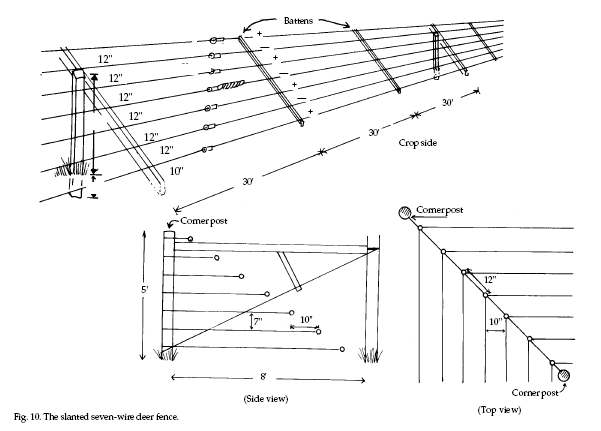
Permanent Woven-Wire
Fencing Woven-wire fences are used for year-round
protection of high-value crops subject to high deer
pressures. These fences are expensive and difficult to
construct, but easy to maintain. Before high-tensile
electric fencing, wovenwire fences were used most often
to protect orchards or nurseries where the high crop
value, perennial nature of damage, acreage, and 20-year
life span of the fences justified the initial costs.
Cost, excluding labor, is about $2 to $4 per linear foot
($5.50 to $11/m). The high cost has resulted in reduced
use of woven-wire fences.
To build a deer-proof
woven-wire fence (Fig. 11), follow the steps below.
(1) Set rigid corner
assemblies where necessary (see the section on Fence
Construction—Rigid brace assemblies [Fig. 14]).
(2) String a light wire
between two corners and apply light tension.
(3) Set 16-foot (4.9-m)
posts along the wire at 40-foot (12-m) intervals, to a
depth of 4 to 6 feet (1.2 to 1.8 m).
(4) Roll out an 8-foot
(2.4-m) roll of high-tensile woven wire along the line
posts. Attach one end at ground level to a corner post
with steel staples.
(5) Apply 100 pounds (45
kg) of tension to the wire with a vehicle or fence
strainers and attach the wire to line and corner posts
with steel staples.
(6) Repeat steps 4 and 5
as necessary around the perimeter of the fence.
(7) Attach two strands of
high-tensile smooth wire to the top of the fence to
raise the height of the entire fence to 9 to 10 feet
(2.7 to 3 m).
Minimal maintenance is
required. Inspect for locations where deer can crawl
under the fence.

Fencing Tips
Materials. Do not
buy cheap materials to reduce costs. This will only
reduce the effectiveness and life span of the fence. We
recommend using:
(1) Round fiberglass or
treated wood posts.
(2) High-quality
galvanized wire and steel components. For high-tensile
fences, use 11- to 14-gauge (0.31-to 0.21-cm) wire
(minimum tensile strength of 200,000 pounds [90,000kg]
and a minimum breaking strength of 1,800 pounds [810
kg]), tension springs, and in-line tensioners.
(3) Compression sleeves
for splicing wires and making electrical connections.
(4) Lightning arresters
and diverters to protect chargers.
(5) High-quality fence
chargers. Chargers must be approved by Underwriters
Laboratories (UL) or the Canadian Standards Association
(CSA). We highly recommend 110-volt chargers. Six and
12-volt chargers require battery recharging every 2 to 4
weeks. Use solar panels in remote areas to charge
batteries continuously. For high-tensile fences, use
high-voltage, low-impedence chargers only (3,000 to
5,000 volts and current pulse duration of at most
1/1,000 second).
(6) Gates. There is no
universal gate design because of the many different
fence types. Gates should be electrified,
well-insulated, and practical for the type of farming
operation. Gates range from single strands of
electrified wire with gate handles to electrified panel
or tubular gates (Fig. 12).

Fence Construction.
Fences must be properly constructed--do not deviate from
fence construction guidelines.
(1) Prepare fencelines
before construction. It is easier and less expensive to
install and maintain fences on clear, level runs.
Minimize corners to increase strength and reduce costs.
(2) Ensure that the
electrical system is well grounded at the fence charger
and every 1/2 mile (880 m) of fenceline. To ground
high-tensile fences, drive four to six ground rods 5 to
6 feet (1.5 to 1.8 m) deep and 6 feet (1.8 m) apart.
Connect the ground post of the fence charger and the
negative (-) wires of the fence to the grounding system
(Fig. 13).
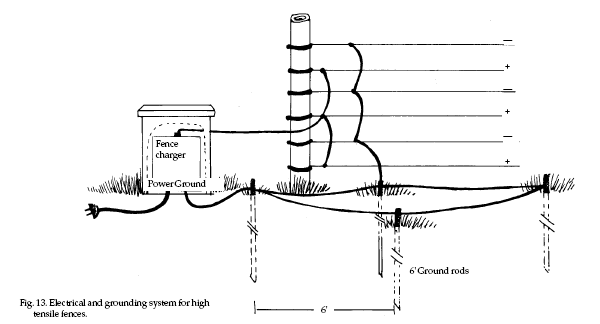
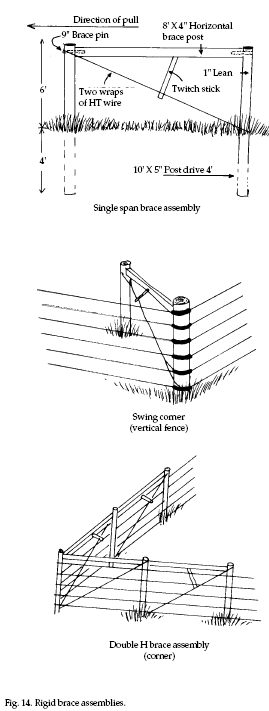 (3)
The wiring system in figure 13 illustrates a
positive-negative fence. Such a design is especially
useful with dry or frozen ground. A fence with all
positive (hot) wires may be advantageous under general
crop and soil moisture conditions. Consult with a
fencing contractor or expert for the best choice for
your needs. (3)
The wiring system in figure 13 illustrates a
positive-negative fence. Such a design is especially
useful with dry or frozen ground. A fence with all
positive (hot) wires may be advantageous under general
crop and soil moisture conditions. Consult with a
fencing contractor or expert for the best choice for
your needs.
(4) Install the grounding
systems and fence charger before fence construction.
Energize completed parts of the fence when you are not
working on the fence to gain early protection.
(5) Rigid brace assemblies
corners, ends, and gates make up the backbone of all
high-tensile fence systems (Fig. 14). They must be
entirely rigid, constructed of the best materials, and
strictly conform to design guidelines. The single-span
brace assembly is the basis of all high-tensile strainer
assemblies, regardless of location in the fence or fence
design. This basic design is then modified to create
double-braces, swing corners, and gate ends.
(6) Allow wires to slide
freely through insulators on fence posts. Fence
flexibility is necessary to endure frequent temperature
changes, deer hits, and obstructions.
(7) Identify an electric
fence with warning signs (Fig. 15) that are affixed at
300-foot (90-m) intervals or less.
Maintenance.
Regular inspection and maintenance are necessary to
ensure the effective operation and longevity of most
fences.
(1) Control vegetation
near fences by mowing or applying herbicides to avoid
excessive fence grounding by weeds.
(2) On slopes or highly
erodible soils, maintain a good sod cover beneath fences
to avoid fenceline erosion.
(3) Always keep the fence
charger on. Check the fence voltage weekly with a
voltmeter. Maintain at least 3,000 volts at the furthest
distance from the fence charger. Disconnect the lower
wires if they are covered by snow.
(4) In late fall and early
summer, adjust the fence tension (150 to 250 pounds [68
to 113 kg]) for high-tensile fences.
Tree Protectors
Use Vexar®, Tubex®,
plastic tree wrap, or woven-wire cylinders to protect
young trees from deer and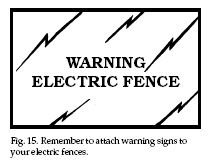 rabbits. Four-foot (1.2-m) woven-wire cylinders can keep
deer from rubbing tree trunks with their antlers.
rabbits. Four-foot (1.2-m) woven-wire cylinders can keep
deer from rubbing tree trunks with their antlers.
Haystack Protection
Wooden panels have
traditionally been used to exclude deer and elk from
haystacks. Stockyards have also been protected by welded
wire panels and woven wire. More recently haystacks have
been protected by wrapping them with plastic Tensar®
snow fence. The material comes in 8-foot (2.4-m) rolls
and is relatively light and easy to use.
Cultural Methods and Habitat Modification
Damage to ornamental
plants can be minimized by selecting landscape and
garden plants that are less preferred by deer. In many
cases, original landscape objectives can be met by
planting species that have some resistance to deer
damage. Table 1 provides a list of plants, ranked by
susceptibility to deer damage. This list, developed by
researchers at Cornell University, is applicable for
most eastern and northern states. A similar list with a
western emphasis was produced by Cummings et al. (1980).
Harvest crops as early as
possible to reduce the period of vulnerability to deer.
Plant susceptible crops as far from wooded cover as
possible to reduce the potential for severe damage.
Habitat modification is not recommended. Destruction of
wooded or brushy cover in hopes of reducing deer use
would destroy valuable habitat for other wildlife. Also,
since deer forage over a large area it is unlikely that
all available deer cover would be on a farmer’s or
rancher’s land.
Lure crops have been
planted to attract deer away from highways and crop
fields where deer traditionally caused damage. Their
effectiveness has been variable and concern has been
raised that an artificial food source may eventually
increase deer densities and resultant problems. Specific
recommendations are not yet available regarding plant
selection, timing, and proximity of lure crops.
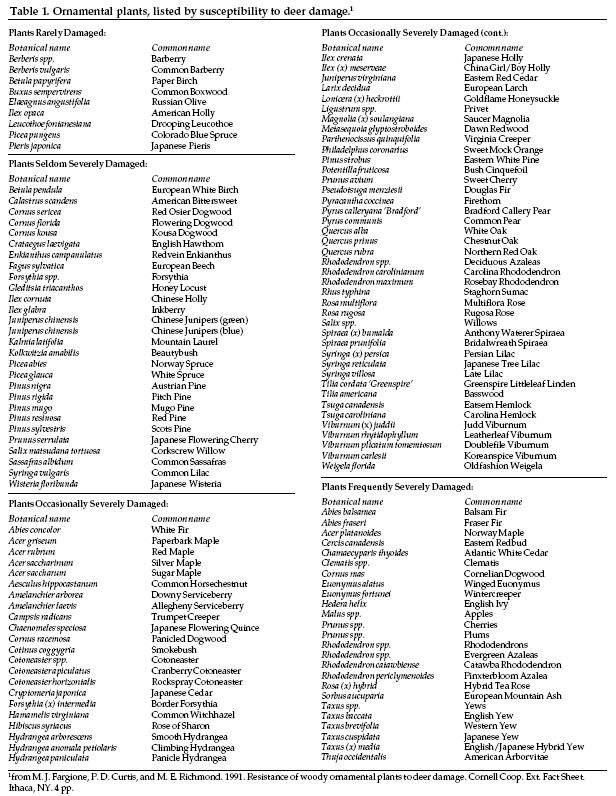
Contraception
Promising research on the
use of chemosterilants and immunocontraception to reduce
or eliminate reproduction is underway. Specificity,
efficacy, and delivery of contraceptive agents, however,
continue to be problems. The use of contraception for
herd control will be best suited to urban parks,
refuges, and other discrete areas. It is unlikely that
contraception can or will be applied in
rural/agricultural landscapes.
Frightening
One of the keys to success
with frightening devices and repellents is to take
action at the first sign of a problem. It is difficult
to break the movements or behavioral patterns of deer
once they have been established. Also, use frightening
devices and repellents at those times when crops are
most susceptible to damage, for example, the silking to
tasseling stages for field corn or the blossom stage for
soybeans.
Gas exploders set to
detonate at regular intervals are the most commonly used
frightening devices for deer. They can be purchased for
$200 to $500 from several commercial sources (see
Supplies and Materials). The devices are sometimes
available on loan from wildlife refuges or agencies as
they are frequently used to control waterfowl damage. To
maximize the effectiveness of exploders, move them every
few days and stagger the firing sequence. Otherwise, the
deer quickly become accustomed to the regular pattern.
The noise level can be increased by raising exploders
off the ground. Motion-activated firing mechanisms are
now being explored to increase the effectiveness of
exploders. Success depends on many factors and can range
from good to poor. A dog on a long run or restricted by
an electronic invisible fence system can keep deer out
of a limited area, but care and feeding of the dog can
be time-consuming. Free-running dogs are not advisable
and may be illegal.
Shell crackers, fireworks,
and gunfire can provide quick but temporary relief from
deer damage. Equip mobile units with pyrotechnics,
spotlights, and two-way radios. Patrol farm perimeters
and field roads at dusk and throughout the night during
times of the year when crops are most susceptible to
damage. Such tactics cannot be relied on for an entire
growing season.
Repellents
Repellents are best suited
for use in orchards, gardens, and on ornamental plants.
High cost, limitations on use, and variable
effectiveness make most repellents impractical on row
crops, pastures, or other large areas. Success with
repellents is measured in the reduction, not total
elimination, of damage.
Repellents are described
by mode of actions as “contact” or “area.”
Contact repellents, which are applied directly to the
plants, repel by taste. They are most effective when
applied to trees and shrubs during the dormant period.
New growth that appears after treatment is unprotected.
Contact repellents may reduce the palatability of forage
crops and should not be used on plant parts destined for
human consumption. Hinder® is an exception in that it
can be applied directly on edible crops.
Area repellents are
applied near the plants to be protected and repel deer
by odor alone. They are usually less effective than
contact repellents but can be used in perimeter
applications and some situations where contact
repellents cannot.
During the winter or
dormant season, apply contact repellents on a dry day
when temperatures are above freezing. Treat young trees
completely. It will be more economical to treat only the
terminal growth of older trees. Be sure to treat to a
height of 6 feet (1.8 m) above expected maximum snow
depth. During the growing season, apply contact
repellents at about half the concentration recommended
for winter use.
The effectiveness of
repellents will depend on several factors. Rainfall will
dissipate some repellents, so reapplication may be
necessary after a rain. Some repellents do not weather
well even in the absence of rainfall. Deer’s hunger
and the availability of other more palatable food will
have a great effect on success. In times of food stress,
deer are likely to ignore either taste or odor
repellents. When using a commercial preparation, follow
the manufacturer’s instructions. Don’t overlook new
preparations or imaginative ways to use old ones. The
following discussion of common repellents is incomplete
and provided only as a survey of the wide range of
repellent formulations available. The repellents are
grouped by active ingredient. Trade names and sample
labels for some products are provided in the Supplies
and Materials
Deer-Away® Big Game
Repellent (37% putrescent whole egg solids).>This
contact (odor/taste) repellent has been used extensively
in western conifer plantations and reported in field
studies to be 85% to 100% effective. It is registered
for use on fruit trees prior to flowering, as well as
ornamental and Christmas trees. Apply it to all
susceptible new growth and leaders. Applications weather
well and are effective for 2 to 6 months. One gallon
(3.8 l) of liquid or 1 pound (0.45 kg) of powder costs
about $32 and covers 400, 3-inch (7.6-cm) saplings or
75, 4-foot (1.2-m) evergreens.
Hinder® (15% ammonium
soaps of higher fatty acids). This area repellent is one
of the few registered for use on edible crops. You can
apply it directly to vegetable and field crops, forages,
ornamentals, and fruit trees. Its effectiveness is
usually limited to 2 to 4 weeks but varies because of
weather and application technique. Reapplication may be
necessary after heavy rains. For small fields and
orchards, you can treat the entire area. For larger
areas, apply an 8-to 15-foot (2.4- to 4.6-m) band around
the perimeter of the field. Apply at temperatures above
32°F (0o C). Four gallons (15.2 l) of liquid cost about
$80, and when mixed with 100 gallons (380 l) of water
will cover 1 acre (0.4 ha). Hinder is compatible for use
with most pesticides. Thiram (7% to 42%
tetramethylthiuram disulfide). Thiram, a fungicide that
acts as a contact (taste) deer repellent, is sold under
several trade names--Bonide Rabbit-Deer Repellent®,
Nott™s Chew-Not, and Gustafson 42-S®, among others. It
is most often used on dormant trees and shrubs. A liquid
formulation is sprayed or painted on individual trees.
Although Thiram itself does not weather well, adhesives
such as Vapor Gard® can be added to increase its
resistance to weathering. Thiram-based repellents also
protect trees against rabbit and mouse damage. Two
gallons (7.6 l) of 42% Thiram cost about $50 and when
mixed with 100 gallons (380 l) of water will cover 1
acre (0.4 ha). Cost varies with the concentration of
Thiram in the product.
Miller™s Hot Sauce® Animal
Repellent (2.5% capsaicin). This contact (taste)
repellent is registered for use on ornamentals,
Christmas trees, and fruit trees. Apply the repellent
with a backpack or trigger sprayer to all susceptible
new growth, such as leaders and young leaves. Do not
apply to fruit-bearing plants after fruit set. Vegetable
crops also can be protected if sprayed prior to the
development of edible parts. Weatherability can be
improved by adding an antitranspirant such as Wilt-Pruf®
or Vapor Gard®. Hot Sauce and Vapor Gard® cost about $80
and $30 per gallon (3.8 l) respectively. Eight ounces
(240 ml) of Hot Sauce and two quarts (1.9 l) of anti-transpirant
mixed with 100 gallons (380 l) of water will cover 1
acre (0.4 ha).
Tankage (putrefied meat
scraps). Tankage is a slaughterhouse by-product
traditionally used as a deer repellent in orchards. It
repels deer by smell, as will be readily apparent. To
prepare containers for tankage, remove the tops from
aluminum beverage cans, puncture the sides in the middle
of the cans to allow for drainage and attach the cans to
the ends of 4-foot (1.2 m) stakes. Drive the stakes into
the ground, 1 foot (0.3 m) from every tree you want to
protect or at 6-foot (1.8-m) intervals around the
perimeter of a block. Place 1 cup (225 g) of tankage in
each can. You can use mesh or cloth bags instead of
cans. You may have to replace the containers
periodically because fox or other animals pull them down
occasionally. Tankage is available by bulk ($335 per ton
[$302/mt]) or bag ($20 per 50 pounds [22.5 kg]). When
prepared for hanging on stakes, it costs about $0.20 per
1 ounce (28 g) bag and 300 bags will cover 2 acres (0.8
ha).
Ro-pel® (benzyldiethyl
[(2,6 xylylcarbamoyl) methyl] ammonium saccharide
(0.065%), thymol (0.035%). Ro-pel® is reported to repel
deer with its extremely bitter taste. Apply Ro-pel® once
each year to new growth. It is not recommended for use
on edible crops. Spray at full strength on nursery and
Christmas trees, ornamentals, and flowers. One gallon
(3.8 l) costs $50 and covers about 1 acre (0.4 ha) of 8-
to 10-foot (2.4- to 3.0-m) trees.
Hair Bags (human hair).
Human hair is an odor (area) repellent that costs very
little but has not consistently repelled deer. Place two
handfuls of hair in fine-mesh bags (onion bags, nylon
stockings). Where severe damage occurs, hang hair bags
on the outer branches of individual trees with no more
than 3 feet (0.9 m) between individual bags. For larger
areas, hang several bags, 3 feet (0.9 m) apart, from a
fence or cord around the perimeter of the area to be
protected. Attach the bags early in spring and replace
them monthly through the growing season. You can get
hair at local barber shops or salons.
Bar Soap. Recent studies
and numerous testimonials have shown that ordinary bars
of soap applied in the same manner as hair bags can
reduce deer damage. Drill a hole in each bar and suspend
it with a twist tie or soft cord. Each bar appears to
protect a radius of about 1 yard (1 m). Any inexpensive
brand of bar soap will work. Ready-to-use bars cost
about $0.20 each.
Toxicants
No toxicants are
registered for deer control. Poisoning of deer with any
product for any reason is illegal and unlikely to be
tolerated by the public.
Herd Reduction
Overall reduction in a
states deer population might reduce deer damage, but
public opinion generally does not favor this approach.
Damage may result from a few problem deer or at
locations close to a winter deer yard or other
exceptional habitat. Thus, a local reduction in deer
population may be appropriate.
Live Capture
In special cases, such as
city parks, refuges, or suburban neighborhoods, it may
be necessary or desirable to capture deer alive and move
them to other areas. Deer can be captured safely with
rocket nets, drop-door box traps, or tranquilizer guns,
but these techniques are expensive, time-consuming, and
require the expertise of professional wildlife
biologists. Live capture and relocation is seldom a
practical alternative unless delicate public relations
problems mandate live removal as the only choice. During
1982, 15 deer were removed from a Milwaukee, Wisconsin
nature area using chemical immobilization. Total cost
was about $100 per deer but other more recent removal
operations have been more expensive, up to $400 per deer
or more. In addition to high costs, the survival of
relocated deer is usually low. Live removal is seldom
justified.
Shooting
Effective use of the legal
deer season is probably the best way to control deer
populations. By permitting hunting, landowners provide
public access to a public resource while at the same
time reducing deer damage problems. Because of the daily
and seasonal movements of deer, only rarely does a
single landowner control all the land a deer uses. As a
result, neighboring landowners should cooperate.
Landowners, the state wildlife agency, and local hunters
should reach a consensus about a desirable population
level for an area before deer are removed.
Mechanisms for managing
deer population levels in a specific area already exist
in most states. Either-sex seasons, increased bag
limits, antlerless-only permits, special depredation
seasons, and a variety of other management techniques
have been used successfully to reduce deer numbers below
levels achieved by traditional bucks only regulations.
Shooting permits issued by
some states allow for removal of problem deer where they
are causing damage during nonhunting season periods.
Use of bait, spotlights,
and rifles may increase success but techniques must be
consistent with the specifications of the permits. In
areas where shooting normally is prohibited, such as
parks and densely populated areas, a skilled shooter
under permit is probably preferable to costly attempts
at live removal.
Economics of Damage and Control
A national survey
conducted by USDA™s National Agricultural Statistics
Service in 1992 identified deer damage as the most
widespread form of wildlife damage. Forty percent of the
farmers reporting had experienced deer damage. No
estimate exists of nationwide annual crop losses to
deer, but damage estimates have been made for some
states. In Wisconsin, a 1984 survey of farmers suggested
minimum statewide deer damage of $36.7 million annually.
A similar study in Pennsylvania estimated the annual
crop loss at $16 to $30 million. The situation is
similar in most agricultural states with moderate to
high deer densities. Estimates by Hesselton and
Hesselton (1982) suggest that the cost of deer-vehicle
collisions may exceed $100 million each year in the
United States and Canada. In fact, the cost of deer/
vehicle collisions was estimated at $100 million in
Wisconsin alone in 1990.
Deer also damage
nurseries, landscape plantings, and timber regeneration.
However, as established earlier, deer are a valuable
public resource. Cost estimates for control techniques
were presented with the appropriate techniques. A
cost/benefit analysis is always advisable before
initiating a control program.
Two additional economic
aspects are worth consideration. One involves farmer
tolerance for deer damage. Two summaries of social
science research related to deer damage (Pomerantz et
al. 1986, and Siemer and Decker 1991) demonstrated that
a majority of farmers were willing to tolerate several
hundred dollars in deer damage in exchange for the
various benefits of having deer on their land. Thus
total damage figures are misleading because only a small
percentage of the farmers statewide or nationwide are
suffering sufficient damage to warrant control or
compensation.
The second economic
consideration involves state-funded programs of
subsidies for damage control materials or direct
compensation for crop losses. Such programs can be very
costly but are probably necessary where large deer herds
are maintained in agricultural landscapes. As an
example, the Wisconsin Wildlife Damage Program expended
$2.25 million in 1992 for abatement materials, claims,
and administration. The program is a collaborative
effort of the Wisconsin Department of Natural Resources,
USDA-APHIS-ADC, and Wisconsin counties and is very
effective. Individual states vary greatly, however, in
their degree of financial or technical assistance.
Consult your state wildlife agency for information on
compensation or cost-sharing programs. Also, many states
have local publications on deer and deer
damage--Pennsylvania, Wisconsin, Minnesota, Michigan,
and New York, for example. Consult your local Extension
office or state wildlife agency.
Acknowledgments
Figures 1 and 5 from
Schwartz and Schwartz (1981).
Figure 2 by Charles W.
Schwartz, published in Wallmo (1978), copyrighted by the
Wildlife Management Institute and adapted by Emily Oseas
Routman.
Figures 3 and 4 adapted
from Burt and Grossenheider (1976) by Jill Sack Johnson.
Figures 6 through 15 are
from Craven and Hygnstrom (1993), “Controlling Deer
Damage in Wisconsin,” University of Wisconsin
Extension publication G3083.
For Additional Information
Andelt, W. F., K. P. Burnham, and J. A. Manning. 1991.
Relative effectiveness of repellents for reducing mule
deer damage. J. Wildl. Manage. 55:341-347.
Burt, W. H., and R. P.
Grossenheider. 1976. A field guide to the mammals, 3d
ed. Houghton Mifflin Co., Boston. 289 pp.
Conover, M. R. 1984.
Effectiveness of repellents in reducing deer damage in
nurseries. Wildl. Soc. Bull. 12:399-404.
Cummings, M. W., M. H.
Kimball, and W. M. Longhurst. 1980. Deer-resistant
plants for ornamental use. Leaflet 2167. Div. Agric. Sci.,
Univ. California. Oakland. 7 pp.
Fargione, M. J., P. D.
Curtis, and M. E. Richmond. 1991. Resistance of woody
ornamental plants to deer damage. Cornell Coop. Ext.
Fact Sheet. Ithaca, NY. 4 pp.
Gallagher, B. 1992. 9th
international power fence manual. Gallagher Power Fence,
Inc., San Antonio, Texas. 45 pp.
Halls, L. K. 1978.
White-tailed deer. Pages 43-65 in J. L. Schmidt and D.
L. Gilbert, eds. Big game of North America: ecology and
management. Stackpole Books, Harrisburg, Pennsylvania.
Halls, L. K., Ed. 1984.
White-tailed deer: ecology and management. Stackpole
Books, Harrisburg, Pennsylvania. 870 pp.
Harris, M. T., W. L.
Palmer, and J. L. George. 1983. Preliminary screening of
white-tailed deer repellents. J. Wildl. Manage.
47:516-519.
Hesselton, W. T., and R.
A. M. Hesselton. 1982. White-tailed deer. Pages 878-901
in J. A. Chapman and G. A. Feldhamer, eds. Wild mammals
of North America: biology, management and economics. The
Johns Hopkins Univ. Press, Baltimore, Maryland.
Mackie, R. J., K. L.
Hamlin, and D. F. Pac. 1982. Mule deer. Pages 862-877 in
J. A. Chapman and G. A. Feldhamer, eds. Wild mammals of
North America: biology, management and economics. The
Johns Hopkins Univ. Press, Baltimore, Maryland.
Palmer, W. L., R. G.
Wingard, and J. L. George. 1983. Evaluation of
white-tailed deer repellents. Wildl. Soc. Bull.
11:164-166.
Pomerantz, G. A., C. Ng,
and D. J. Decker. 1986. Summary of research on human
tolerance of wildlife damage. Nat. Resour. Res. Ext.
Ser. No. 25. Dep. Nat. Resour., Cornell Univ., Ithaca,
New York. 42 pp.
Selders, A. W., J. B.
McAnninch, and R. J. Winchcombe. 1981. High-tensile wire
fencing. Northeast Regional Agric. Eng. Serv. Bull. 11.
Cornell Univ., Ithaca, New York. 14 pp.
Siemer, W. F., and D. J.
Decker. 1991. Human tolerance of wildlife damage:
synthesis of research and management implications. Human
Dimensions Res. Unit, Ser. No. 91-7. Dep. Nat. Resour.,
Cornell Univ., Ithaca, New York. 24 pp.
Stapells, R. D. H. 1983.
Everything you should know about electric fences and
fence controllers. J. C. Hallman Mfg. Co. Ltd. Kitchaner,
Ontario. 30 pp.
Swihart, R. K., and M. R.
Conover. 1990. Reducing deer damage to yews and apple
trees: testing Big Game Repellent® Ro-pel®, and soap
as repellents. Wildl. Soc. Bull. 18:156-162.
US Steel Corporation.
1980. How to build fences with USS Max-Ten 200
high-tensile fence wire. No. T-111575 US Steel Corp.
Pittsburgh, Pennsylvania. 75 pp.
Wallmo, O. C. 1978. Mule
and black-tailed deer. Pages 32-42 in J. L. Schmidt and
D. L. Gilbert, eds. Big game of North America: ecology
and management. Stackpole Books, Harrisburg,
Pennsylvania.
Editors
Scott E. Hygnstrom Robert
M. Timm Gary E. Larson
PREVENTION AND CONTROL OF
WILDLIFE DAMAGE — 1994
Cooperative Extension
Division Institute of Agriculture and Natural Resources
University of Nebraska -Lincoln
United States Department
of Agriculture Animal and Plant Health Inspection
Service Animal Damage Control
Great Plains Agricultural
Council Wildlife Committee
Special
thanks to:
Clemson University
|